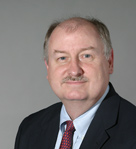Home
Previous Issue
Next Issue
College Home
College Calendar
Aggie Daily
- - - - - - - - - - - - - -
Media contact:
Phillip Rollfing
979.458.0442
email |
| |
| |
Heathcare Design

Professor-architect is proponent of
evidence-based healthcare design
| |
|
Texas A&M University architecture professor Kirk Hamilton
is a man on a mission: he's determined to make his discipline
more rigorous by focusing on objectively measuring the impacts
of designers' choices on the environments and occupants of
the structures they build.
Hamilton, a registered architect who specialized in hospital
design for 30 years and was an owner of a 120-person firm before
joining Texas A&M, also earned a masters degree in organizational
development, a process that convinced him to embrace the tenets
of evidence-based design.
"My
work in practice and my studies at Pepperdine University convinced
me that hospital designers must work like doctors,
relying on evidence as the basis of their decisions," Hamilton
says. "If the profession refuses to evolve in this direction,
we run the risk of becoming just highly educated draftsmen.
We explore the relationship between evidence-based design of
healthcare facilities and measurable performance of the organizations
which use those facilities, and we must report our findings."
Hamilton's work was the first to be published applying such
social science measurement methods to healthcare building design.
He has proposed a certification process by which evidence-based
projects could be compared, and the Robert Wood Johnson Foundation
is funding a pilot program to make that process happen. Bases
for such comparisons might include overall organizational performance
judged by financial and economic indicators (margin, average
cost per patient day), clinical and safety measures, ways in
which healing environments reduce stress, performance improvements
in efficiency and systems initiatives, usage and leverage of
medical, computer and labor-saving technologies, and sustainable
design, including energy consumption, material selection, water
conservation and site planning.
"While
the concept of evidence-based design has been appealing to
many architects and design professionals, there are elements
of the process that may require acquisition of new capabilities," Hamilton
notes. "As the typical practitioner develops evidence-based
skills, he or she also needs to develop mastery of the literature
search, the use of applied research methodologies in the field,
and an understanding of the intellectual rigor needed in the
interpretation and reporting of findings. These efforts are
worth it, because they promise higher levels of performance
and superior results in the final design and development of
a project."
In his current role at the College of Architecture, Hamilton
can help future architects learn these skills. He came to Texas
A&M in 2004 as part of the college's "signature faculty" program,
designed to attract seasoned professionals to teach in its
design studios. He is a tenured associate professor in the
architecture department and a fellow in the college's Center
for Health Systems and Design.
During just two years, Hamilton has created new courses centered
around the foundations and evolution of healthcare architecture
and typologies of contemporary hospital design, and he plans
another course in designing facilities to maximize organizational
performance. Students seeking the healthcare certificate offered
to master of architecture candidates have been quick to embrace
Hamilton's approach.
"Professor
Hamilton's expertise and experience has enriched our knowledge
of evidence based design. His unique approach
to teaching has directly influenced my desire to pursue a career
in healthcare architecture. Professor Hamilton's knowledge
of organizational culture gave me specific ways to achieve
my learning goals and actualize my career path," said
Chris Grossnicklaus, second-year master of architecture student.
Hamilton sees himself as a guide or an interpreter for what
he terms the "emergent idea" of evidence-based hospital
design based on clinical and social science evidence, neither
of which comprise the traditional bases of architectural design.
For example, he continues to advise practitioners on what constitutes "best
evidence" on which to base the design process.
"As
many of my colleagues, like Leonard Berry at Mays Business
School and Mardelle Shepley, Jim Varni and Roger Ulrich here
at this college, have shown, there is powerful evidence that
the physical environment impacts patient psychology and physiology
and thus clinical outcomes," Hamilton says. "True
evidence-based design offers the promise of a bright and exciting
future for healthcare architecture. We want to create an approach
to designing patient- and family-centered healthcare facilities
that provide healing, therapeutic environments for the real
people that will use them. Now that we understand the connection,
we have no less than a moral obligation to do so."
| |
 Kirk Hamilton
Kirk Hamilton
|
|
| |
|
|

